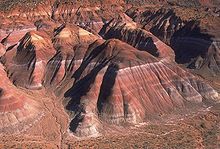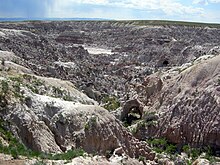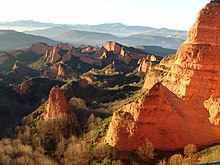Badlands




Badlands are a type of arid terrain where softer rocks and clay-rich soils have been extensively eroded by wind and water. Canyons, ravines, gullies, hoodoos and other such geological forms are common in badlands. They are often difficult to navigate by foot. Badlands often have a spectacular colour display that alternates from dark black/blue coal stria to bright clays to red scoria.
Features
The term "badlands" represents a consensus in North America: the Lakota called the topography "Makhóšiča", literally bad land, while French trappers called it "les mauvaises terres à traverser" – "the bad lands to cross". The term is also apt: badlands contain steep slopes, loose dry soil, slick clay, and deep sand, all of which impede travel and other uses. Badlands form in arid regions with infrequent but intense rain-showers, sparse vegetation, and soft sediments: a recipe for massive erosion.
Some of the most famous fossil beds are found in badlands, where erosion rapidly exposes the sedimentary layers and the scant cover of vegetation makes surveying and fossil hunting relatively easy.
Locations
Some of the best-known badland formations can be found in the United States and Canada. In the U.S., Makoshika State Park in Montana, Theodore Roosevelt National Park in North Dakota and Badlands National Park in South Dakota together form a series of extensive badlands formations. Another popular area of badland formations is Toadstool Geologic Park in the Oglala National Grassland of northwestern Nebraska. The Big Muddy Badlands in Saskatchewan, Canada gained notoriety as a hideout for outlaws. There is a sizable badland area in Alberta, Canada, particularly in the valley of the Red Deer River where Dinosaur Provincial Park is located. The Royal Tyrrell Museum of Palaeontology in Drumheller, Alberta and Dinosaur National Monument in Utah are also badlands settings, and exhibit fossils found in the area. A small badlands called Hell's Half-Acre is present in Natrona County, Wyoming. It is famous as one of the locations for the filming of Starship Troopers (1997).
Arguably the most well known badlands formation in New Zealand, the Putangirua Pinnacles – formed by the erosion of the conglomerate of an old alluvial fan – are located at the head of a small valley near the southern tip of the North island. An European famous badland is the Accona Desert near Siena, Italy.

Although most badland scenery is natural, there are some spectacular examples produced by mining, such as the Roman gold mine of Las Médulas in northern Spain.
